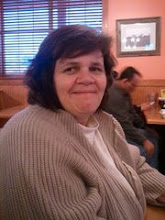
My experience this semester with creating and posting to my own blog has opened up a whole new world for me. Before I started this class, I was unaware of what a blog was let alone ever think about creating one myself. Now, my view has changed as it probably has for most of the students in our class.
Many of the individual blogs from our class are quite good and I wish I had time to read them all, but the classmate's blog that I picked to read was written by Stephanie Ellis. I really enjoyed perusing
Stephanie's blog. She had some interesting posts with pictures to go along with them. I think the blogs that contain some sort of graphic image are more interesting to look at. The pictures also help to catch your attention. My favorite post of Stephanie's was the one she wrote on Randy Pausch. I think we were all moved after watching Randy's video. He accomplished so much in his short lifetime and inspired so many people (including us). Stephanie did a great job of expressing her feelings about the video. Like her, I am not sure if I am an Eeyore or a Tigger either. I think I am more of a Kanga, a born nurturer. That's why I want to be a teacher I guess. I really enjoyed Stephanie's blog. All of her posts seemed to be well thought out and organized (and up to date).
I think we both learned during this semester what a great asset blogging can be to a classroom. The blogs can serve as a reinforcer for information taught in the classroom along with a vehicle to post assignments in, links to websites and other blogs, student's work as well as a source for information and news for the parents as well as students. I also like the idea that, if you start the blog the first week of school, it can serve as an on-line portfolio of the students work for the entire school year. Teachers and parents, as well as students, can see how much the students work has improved over the course of the year. The best part is that blogs are free and easy to create using Google Blogger. You can also access them from any computer.
I found some really good blogs over the course of the semester that I would like to use as a model for my own classroom. One blog that I really liked was "
Mrs. Cassidy's Classroom Blog", which is a class of first graders in Moosejaw, Canada. The children have their own blogs which they post to each week (first graders blogging!). There are also videos of what the children are doing in class as a way to let the rest of the world (including parents and grandparents) into their classroom. What a great idea! This is the type of blog I would want to use in an elementary classroom.
Another great blog was created by a teacher in Connecticut called "
Miller's 10th Grade English Blog". This blog is amazing! Mr. Miller teaches Advanced English at Branford High School. His blog contains everything a student would need such as class calendar, assignments, homework prompts and a link to a wiki, which the students also participate in. This is the type of blog that would be ideal for a middle or high school class. The students have everything they need right there at their fingertips while at the same time Mr. Miller is teaching them how to use the technology.
We also learned that blogs linked together can serve as a web page for the classroom as we did when we created our teaching tools blogs. Selected topics in the educational/technology realm can be linked together and with the click of the mouse we can go from blog post to blog post.
One drawback to using blogs for posting assignments, resources, etc. is that not all students would have computers or internet access at home. It is true that they could access the information at the library but this might become burdensome for a student or a parent. Also, many parents might not allow their children to use the internet at home (without supervision), feeling it is unsafe.
Also, creating a blog and keeping it up to date with current assignments does take a lot of time. It is something that you have to stay on top and update constantly. This might pose a time constraint for some teachers. The students might also feel that since the assignments and material will be available online, in a blog or web page, that they don't need to pay attention in class or take notes. This could lead to day dreaming or behavior problems.
I believe the plusses to classroom blogs far outweigh the minuses. Blogs and
Wikis are something we can use in the classroom as a resource of information for our students along with a way to showcase their work. They are a way to introduce technology to our students while at the same time allowing them to give and get feedback about their work. This is definitely a tool I will be using in my future classroom.















